
Location: Alice Springs, NT
Established: 1985
Architect: Thomson & Wolveridge
First Played: 15th Nov 2016
Last Played: 16th Nov 2016
Magazine Ratings

94 (2016)

90 (2012)

87 (Current)
My first trip into the Northern Territory, was to play a Top 100 Golf Course, Alice Springs Golf Club. Most people come to the area to see the beautiful desert landscapes, including the Macdonnell Ranges, or travelling six hours south to see Uluru. No this crazy person does a 24 hour trip to play golf at what is considered the hottest golf course in the World.

Alice Springs Golf Club Entrance
On the way to the course we passed a few things renown in the area, The Ghan Museum (train that travels from Adelaide to Darwin) and the Flying Doctors Service Museum. In hindsight the trip should have been a day or two longer to take in the sights.
The course is located on the outskirts of town, in what is defined as a tourist area, which includes a casino. A few of the accommodation options along this area, have access to the golf club, making it a quick trip to reach the first tee.

Clubhouse at Alice Springs Golf Club
The clubhouse operates for dinner every night and lunch times over the weekend. An outdoor area located at the rear, overlooks the tenth tee and eighteenth green. Great to sit down and have a nice cool beverage watching the sun go down.
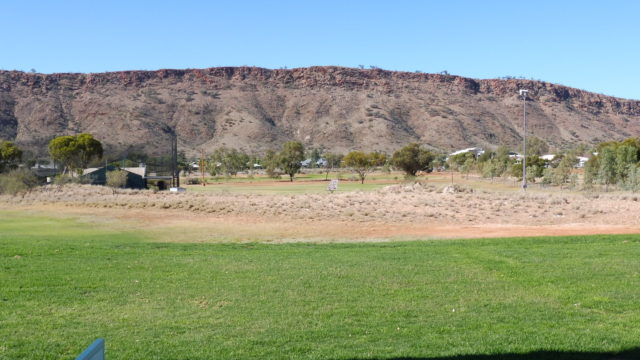
Driving range
There are not many driving ranges in the country which have a spectacular view. This one has the MacDonnell Ranges sitting in the background, but is also flood lit to allow night practice. Unfortunately the hills are not lit up at night, but what a view that would make.

Alice Springs Golf Course Map
The course routes around in two loops of nine. In the first loop the course is a lot narrower at times, whilst the back nine opens up a lot more plus has a couple of water hazards to contend with. Speaking of water, ensure you stock up on liquids as there are not a lot of places to restock on liquid around the course.

Scorecard for Alice Springs Golf Club
Play was mainly from the blue tees, although nine holes were played from the white tees during a police competition the locals had invited me into.

Hole 1 – 334 meter par 4
The first is a shortish par 4 which plays relatively straight, although the fairway is slightly angled away to the right from the tee box. Out of bounds due to housing runs the entire length left, with compacted desert waste between this and the fairway. Mounding is found to the right with trees scattered along the way.
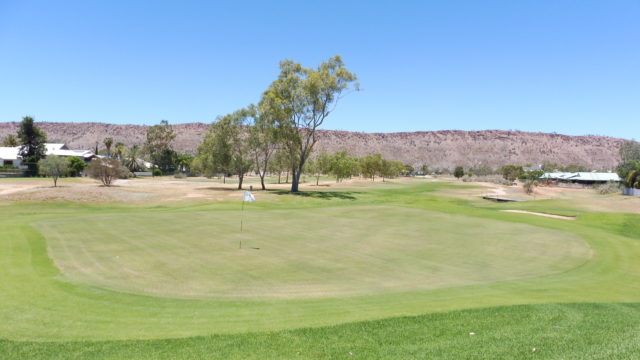
Looking back from the 1st green
A swale is found running the width of the fairway, just short of the green. During heavy rain this can fill with water, requiring the bridge to be used to cross. A large tree is also just short to the right, protruding some way into the fairway. Logically this is the better line into the green due to the bunker on the left, but with the branches sticking out, becomes a higher risk shot. The green itself has varying undulations to contend with and mounding found at the rear. An easier hole to get you into the round, although the last tree could do with a little pruning or removal to open up the line from the right, otherwise it remains a bit one dimensional.
It also came to my attention here that the greens had been maintained within the last few weeks. This was my fault for not checking before booking the trip, but had fully expected maintenance to be have been completed at least a month before. Apparently a couple of events had been recently held, leading to a delay in coring.

Hole 2 – 404 meter par 4
Early in the round, but the hardest hole on the course and longest par 4 is up next. This plays with trees and out of bounds down the left, due to more housing, with a large rocky outcrop down the right. The fairway is not overly wide, but the drainage ditch down the left allows an extension, however leaving a more difficult shot. Whilst on the tee turn to the right where the 8th green can be seen with the Macdonnell Ranges in the background. Quite a view.

View across the 2nd green
Another swale runs across the fairway short of the green, followed by various mounds and a bunker to the left. The putting surface is very generous in width, but finding the wrong portion will leave a tricky putt with its various undulations. A tough hole requiring two long accurate shots. Unfortunately not a lot of strategy here due to the narrow widths. The biggest decision will be on whether you can reach the green with the second, if not where to layup.

Hole 3 – 171 meter par 3
A signature hole on the course, this medium length par 3 plays from an elevated tee, although the green sits at the top of another hill. Take in the scenery, with out of bounds to the left, a rocky hillside to the right and the ranges out in the distance.

Closer look at the 3rd green from the tee
There is some short grass found around the green complex, with quite a bit hidden to the right side. To reach most pin positions the central bunker will need to be carried.

View of the 3rd green
Another hidden aspect from the tee is the bunker located to the right. The green complex falls away on all sides, whilst sloping mainly from the rear. A fairly long putting surface allows for a few clubs difference depending on pin position, but anyone slightly wide will struggle to remain on the green. Visually stunning hole requiring a fairly accurate shot to land on the green. There is quite a bit of forgiveness around the green complex area (except if you are in the bunker), which makes this hole fair for all levels of player.

Hole 4 – 491 meter par 5
Encountering the first hole without housing on either side of the fairway, is the hardest par 5. This is also the equal shortest par 5 (along with the 10th hole). From an elevated tee there is a slight carry to reach the fairway, which has a large hill along the left, sloping away to sparse trees down the right.

View from the 4th fairway
Some slight undulation is found on the fairway, which narrows just short of a swale running across the fairway. Two cross bunkers are found either side of the fairway short of the green. They are that close together I don’t see the point in not joining them, although they really should be staggered a little. Play should be to the left, allowing the ball to finish on the right side of the fairway, due to the moderate sloping.

Looking back from the 4th green
The left side of the green complex is built into the hill, in particular a medium size bunker which is lined on one side with large rocks. Luckily we are not trying to carry a shot over these (very dangerous) but they may interfere with the back swing if you find yourself to close. The land falls away on the other three sides of the green.
Scenic look to the hole, but the fairway becomes quite narrow in the first part of the fairway leading up to the swale. A big choice with the second, on whether the cross bunkers can be carried or laying up. Not a bad hole.

Hole 5 – 124 meter par 3
Playing the second par 3 on the course, is the easiest par 3 and shortest hole. The green sits nestled away below two rocky outcrops. Power lines are potentially in play off the tee, which a local rule handles. Speaking of which, one local rule I found quite odd, was playing the ball where it lies on all paths. There are quite a few around the course, due to high amounts of traffic by carts. With the amount of rocks on the course, be cautious with the clubs. Came back with a bit of a chunk out of my six iron.

Slightly raised 5th green
The green is narrow, but has a bit of length. One solitary bunker sits to the left, but it is the surrounding undulations which make this green complex even partially interesting. Although a small hole, missing in the wrong spot could cause trouble.

Hole 6 – 492 meter par 5
Heading back in the opposite direction is this par 5, measuring one meter longer than the previous. From a slightly raised tee, there doesn’t look like a lot of fairway to hit, with a lot of barren ground between the tee and around the fairway. We have our first true desert bunkers, filled with red earth, rather than the white sand reminding you of the beach (distracted there with a desert illusion). The fairway here angles away to the left from the tee box.

View of the 6th fairway
The fairway is quite open although not finding the short grass may lead to an unusual or unplayable lie, in the dirt or tufts of grass.

Looking across at the 6th green
The green is fairly wide, with a bunker to the left and a mound in the center, which hides a majority of the green. This mound makes playing from the right a lot more difficult, due to a down hill shot to a hidden putting surface. At the rear the ground slopes away, to another bunker hiding behind. Nice hole which has a couple of challenging shots, in particular off the tee and the approach.

Hole 7 – 356 meter par 4
The first hole which turns to the right, around a hill. This tee shot is one of the more deceiving faced, with the fairway sloping to the left. Although the hole is a medium length, running out of fairway is quite easy, especially due to the tee being raised.
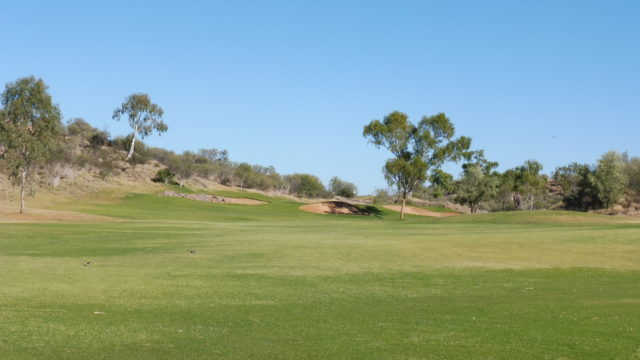
Approach to the 7th fairway
At the turn a small mound is found on the left. The landing area looks extremely small when taking in the surrounding desolate ground, but is quite large once you reach the fairway and look at the approach to the green.

View of the 7th green
Built into the hill, the green sits elevated with two bunkers built into its side on the right. Another bunker is left, again with rocks built into its rear face.

Looking back at the 7th green
Some slopes and mounds are found around the rear, leaving a difficult shot if playing long. I really liked this hole, but played it terribly on both days. Offers a risk vs reward situation from the tee in trying to cut the corner and leave a smaller approach.

Hole 8 – 386 meter par 4
Another signature hole, in my opinion, is the 8th, which winds its way through a small canyon before reaching the green. The tee is elevated, making this play shorter than its published distance. A bunker is built into the hill on the right side and if you find yourself in here, life just got a little more difficult. The recovery shot will be blind over trees to reach the green. This is the side to gain further distance however. On the left, a lot of fairway has been deceptively hidden, making the player take on a tighter line to the right than necessary. This is the safe area to bail out and leave a clearer shot into the green, but slightly longer.

Looking over at the 8th from the 2nd hole
Making the approach is down a gentle slope to a green, with one bunker quite shot and two others at the front. Sloping from the right runs towards the green, whilst the remaining sides slope away. The putting surface slopes from either side towards the middle. A good challenging hole, which asks questions on each shot, but is forgiving enough for all levels of golfer. Enjoyable scenery playing through the rocky outcrops on either side.

Hole 9 – 309 meter par 4
Finishing the first loop is the shortest par 4. This is relatively flat, much like the first, which sits beyond the trees on the right. Out of bounds is located down the left of the fairway, which also has three fairway bunkers.

Looking back at the 9th green
A swale and further bunkers are found just short of the green, which will come into play for longer hitters. The green has various mounds around the rear and a large bunker at the front. Although not on very interesting land, the hole retains some interest with reward being on offer for those trying to reach the green in one, but punish those not quite accurate.


Hole marker and Mal Maninga
Each hole has a sign showing the par, distance, index and gratefully layout, always good if you don’t have a course guide and playing for the first time. The flags were sponsored flags, hence the reason not being shown, but what was interesting is the Mal Maninga (Australian rugby league player and current national team coach) statue located between the third and forth holes.
So why the statue? Informed by a local member out for practice on a few holes during his lunch break, a $2500 bet was raised between two guys, one stating he could get Mal Maninga to his house for lunch. On Knowing that it was unlikely to get the legendary player to his house, local sculptor and artist Mark Egan was asked to create the statue. So Mal did go to the house, just not in real life. Dick Grainger, on the wrong end of the bet even paid up. What a sport.

Hole 10 – 491 meter par 5
Starting the back nine, is the equal shortest par 5. To be honest, at 491 meters it is not really all that short. Designed with a slight sweep to the left, this is the first hole to have water in play down the left side of the fairway. The landing area is quite wide, although a few small mounds are found to the right which may leave an awkward stance if found.

First sign of water beside the 10th fairway
With a fairway sloping mainly right to left, this helps to feed the ball slightly towards the water. A couple of bunkers are found to the right, awaiting those trying to avoid the water.

Large undulating 10th green
Beyond the last bunker, the green, angling away to the right, becomes quite open . The only defence are the mounds built around the sides and rear, along with the various slopes on the putting surface. A distinct difference can be felt already between the front and back nine, with a lot more open space being found. Not a bad hole with a bit of forgiveness being found along the fairway. The last bunker is quite strategic blocking out views of the green, but asking the question on whether to try and carry or for those trying to stay clear of the water.

Hole 11 – 357 meter par 4
A medium length par 4 which has a fairway angling away to the right. Fairway bunkers are staggered on either side, with that on the right closer to the tee. With the design of the hole, it is easy to play through the fairway finding the rough on the left. Finding the correct line for your distance is critical.

The 11th green with McDonnell Ranges behind
Another green which sits slightly raised with one trap at its entry. Its size is average with small mounds found around the edges. Not the most exciting hole due to the flat fairway, but quite good design which can quite easily catch the player out, particularly from the tee.

Hole 12 – 191 meter par 3
Without doubt the longest and hardest par 3 on the course. The perspective is quite different between the white and blue tee, the white much shorter but more so the angle into the green. A gully must be carried to reach the green.
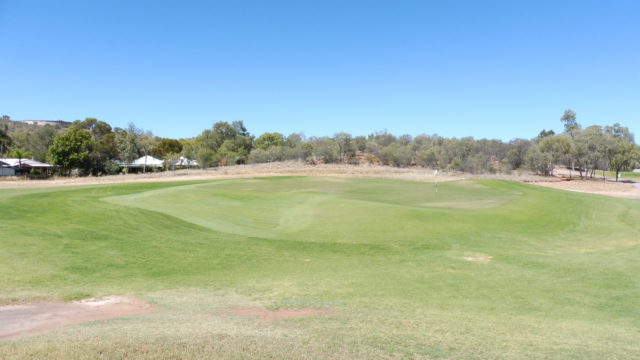
Wide undulating 12th green
The green complex is very wide, with a large amount of areas on the surrounds for any miss. Finding the right portion of the green is critical, with a large hump found in the middle of the green. Being on the wrong side will leave a difficult chip or putt. Tough hole due to distance, but fun can be had on the green. I spent a little bit of extra time here trying a few different shots around the green.
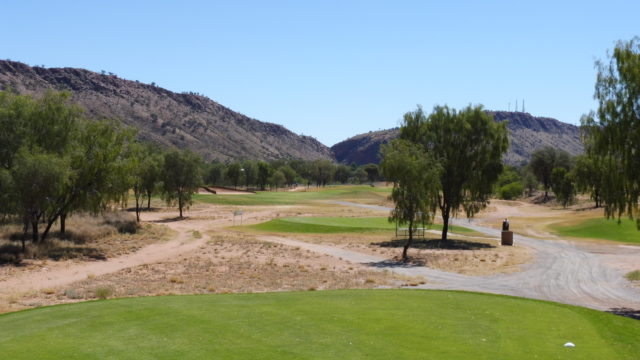
Hole 13 – 378 meter par 4
Playing back in the opposite direction is this mid length par four which turns to the right. From an elevated tee, small trees either side block views of the fairway edge. A large bunker is found out to the left, while some humps are found out to the right. A large swale is found short of the green, although should not really come into play.

Approach from the 13th fairway
The left side is the preferred line into the green, taking the three bunkers on the right slightly out of play, but also some medium size trees short of the green. From the left part of the slightly raised green can also be seen.

Looking across at the 13th green
Testing hole, more so with the approach. Missing on the wrong side of the green will leave a difficult pitch, especially right of the bunkers.

Hole 14 – 500 meter par 5
Still playing in the same direction is the longest hole on course and easiest par 5. The hole has a large sweep to the left, with mounds down inside of the turn. Ample room is found on the fairway to land the tee shot. Willy, one of the locals I had met over the two days, played the back nine with me on the last round for the trip. Having only started playing a few years previously, his short game was fantastic. I can highly praise how welcoming the members were to me, with most quite interested in the quest to play the top 100.

Bunkers along the 14th fairway
Beyond the large swale through the middle of the fairway, a large bunker is found, which can potentially make the approach shot blind. This hides quite a bit of the fairway and sometimes the green, depending on where the shot is played.

Approach to the 14th green
Another green where most of the putting surface is hidden, due to the complex being raised, but more so the bunker and small undulations to the right. Finding yourself down the right leaves a difficult pitch, with even more of the putting surface being hidden. The use of a large sweep and positioning of the bunkers, makes this hole a bit more appealing, considering the land is relatively flat.

Hole 15 – 171 meter par 3
The last par 3 for the day, plays from a slightly elevated tee. Four bunkers are the thing that really catches the eye, hiding most of the putting surface. The one thing to note is the width available to land the ball.
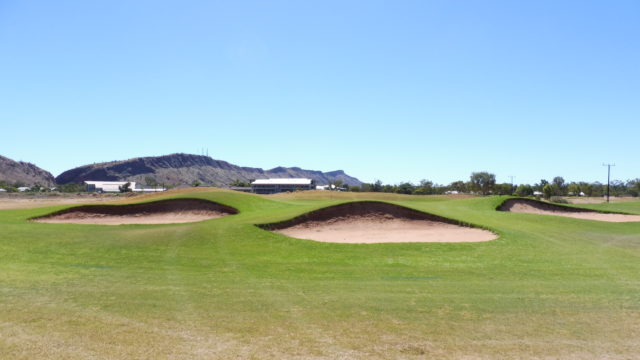
Bunkering on the 15th green
One thing I learnt from my playing partner Brad on the first day, was how the ball would feed into the green, depending on which bunker you played over. Playing over the middle two was preferable, with any over the right two, feeding away from the middle of the putting surface. Interesting hole, having a wall of bunkers protecting the front of the green. This reminding me slightly of the 7th at Royal Adelaide, although these sit level or below the surface of the green, whilst here they sit above. There was still room for play between the bunkers for those not overly long.

Hole 16 – 365 meter par 4
Still playing in the same direction (three holes in a row), was a mid length par 4. A large trap sits in the middle of the fairway, so you either go around or over. With the sand quite firm, some play through the bunker.

Approach from the 16th fairway
Two traps sit out to the left, one green side and the other slightly short. Another is short right, which is the ideal line into the green. Mounding is found at the rear, whilst the putting surface has some gentle slopes, slightly running away to the front. With the ball capable of running through the middle fairway bunker, it does not prove much of an obstacle, there fore really changing how the hole plays.

Hole 17 – 327 meter par 4
With a shorter par four playing back in the opposite direction, which is a good change, especially if the last three had been into head winds. A fairway trap is found to the right and needs to be avoided. This forces play slightly left, a good strategic element from the designers, although longer hitters may carry the trap.

Play over water to the 17th green
From the left of the fairway, water really comes into play to reach the green. Depending on how far left you are, trees may come into play, forcing a shot to the right of the green or laying up short. One trap is found behind the green, along with small mounding. A well designed hole which will offer a variety of options to play.
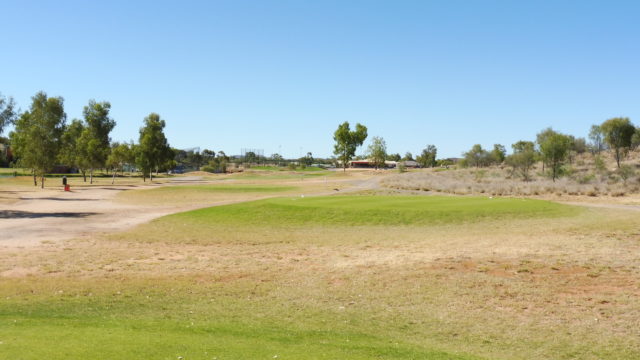
Hole 18 – 346 meter par 4
To finish the round is the easiest hole on course. Being a mid length hole which plays blindly around a slight rise in the fairway, first timers may be caught out by the large sandy waste built across the fairway. The landing area is quite wide yet flat, unless trying to play quite long.
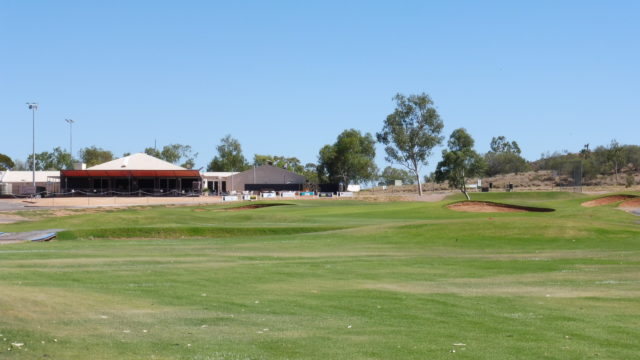
Approach from the 18th fairway
Not visible the large sandy waste is found across the total width of the fairway. This is barely visible even when closer to the area. Driving over the waste is possible from the white tees, but a lot harder from the back.

Looking back from the 18th green
The green complex has four bunkers on its surrounds, three of them over to the right. These hide half of the putting surface, which is quite large in size. Nice hole to finish the round, with some risk vs reward elements incorporated.
Looking at the course makeup:
- Hole Directions – There is not a good variety in hole directions, allowing for conditions to have wide ranging effects during play. Almost Sixty percent are east or west facing, with the rest mixed among the other directions. Consistently throughout the rounds consecutive holes play in the same direction, with the worst case being a run of 4 (13-16). Not an issue if playing down wind but into a headwind would be very frustrating. Potential issues are the second facing east (in the morning sun) and the sixteenth being westerly (in the afternoon sun)
- Hole Lengths – Par three holes had a good variance in distance, but two were almost identical, also playing in a similar way. Par four holes ranged from short to long with the majority being mid length. These varied the most with a good mixture. Par 5 holes where all long, with three almost having identical distances. In fact 9 meters covered the distance in all four par 5’s. Some variety with tee distances should be sought to mix up how they are played
- Hole Layout – There was a good mixture in how the holes played, with an even amount playing left, right and straight. This is in reference to where two shots or more were required to reach the green. The directions varied from small angling of the fairways, to long sweeping turns

Sandscrape previously used at Alice Springs Golf Club
In summary when I first arrived at the course and looked down the first hole, there was some disappointment. The hole looked a bit messy, especially off to the left. This certainly wasn’t anything like Kalgoorlie Golf Course where distinct fairway lines could be seen, before finding yourself in the desert. Alice Springs had lots of compacted earth due to paths and the fairway and desert melding together. It improved though as I moved on. Starting to see rocky outcrops to the sides, giving a lot more distinct look.
The fairways at times where slightly thin, making it feel quite tight at times, in particular on the front nine. This also limited strategy options. It was good to hear that a plan is in place to extend the fairways to their original widths, so would love to go back when this is completed.
Distinct with the green complexes, which definitely had a feel that Thompson and Wolveridge had been involved with the design. Subtle mounding and undulations were found on most of the greens, along with some deceptive slopes.
For me playing the front nine was a lot more enjoyable. Although a bit tighter, there were varying elevation changes, mixing up how the holes were played. The second nine was predominantly flat terrain, although a few holes had slightly elevated tees. This is not to say the back was bad, it was certainly more open and offered other variants, like water hazards on a few holes.
I have read a few reviews on Alice Springs, with some mentioning the course deteriorating over time. It definitely had the feel of a course having been in existence for a while. The condition wasn’t too bad, considering the environment in which it is located.
Most of the front nine was quite memorable, slightly outweighing the standout holes on the second nine. Standouts were 2, 3, 4, 7, 8, 13, 15, 17 and 18.

Daynor, Mal & Brad were great company for the afternoon nine (and drinks)
Really have to mention the members were extremely friendly and accommodating during my visit. On day one I played in the local Police competition after my first round. This was only nine holes but my playing partners, Brad, Mal and Daynor were a great bunch, enlightening me with some of the course intricacies and history. The second day saw play with Willy over the last nine, again learning a bit more about the course, but more so how accommodating, even offering a lift to the airport after the round.
So this was a desert experience, slightly different to my first encounter, but still worth the trek. I will return one day, well after or before the greens have been maintained and the fairway widths have grown a little.
How to play at Alice Springs Golf Club:
1. The course is open to the public 7 days a week

